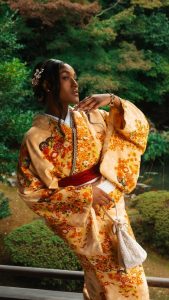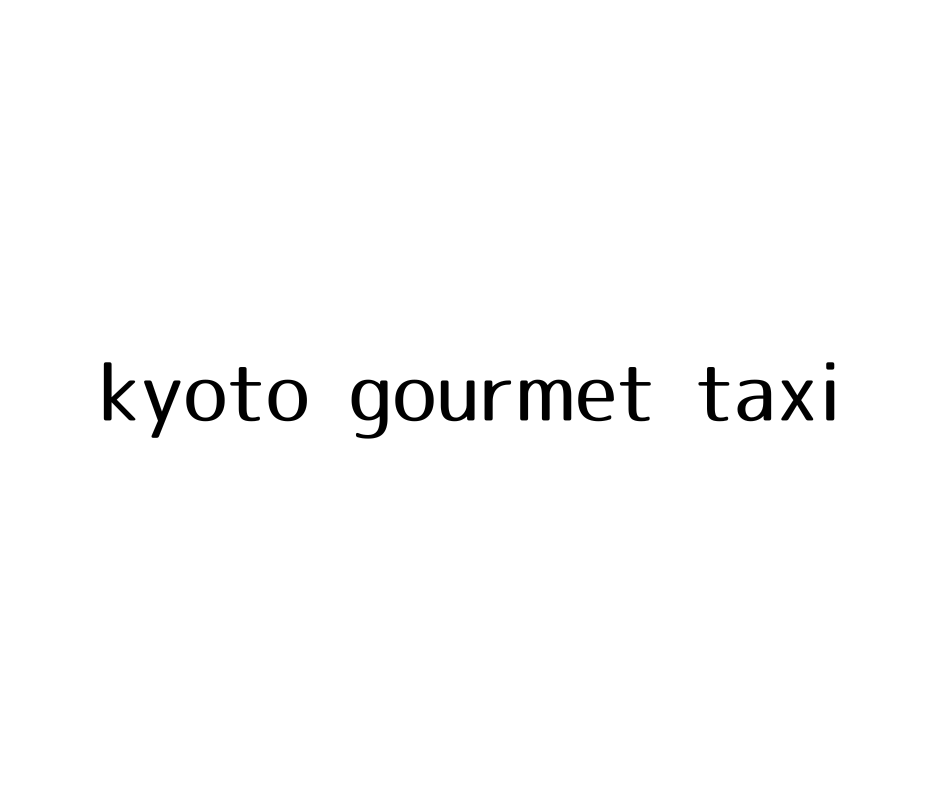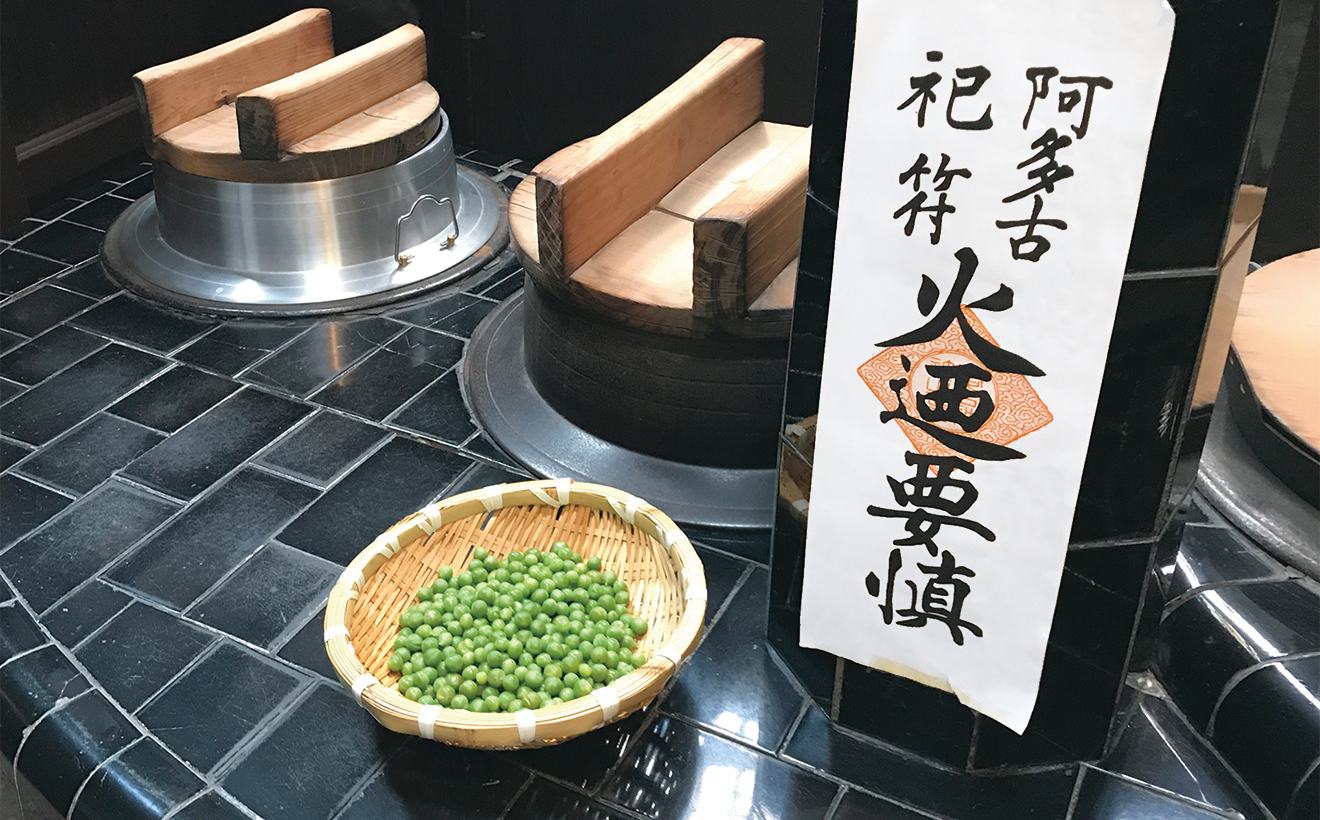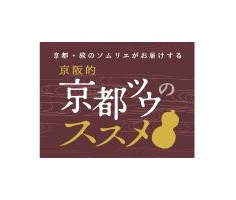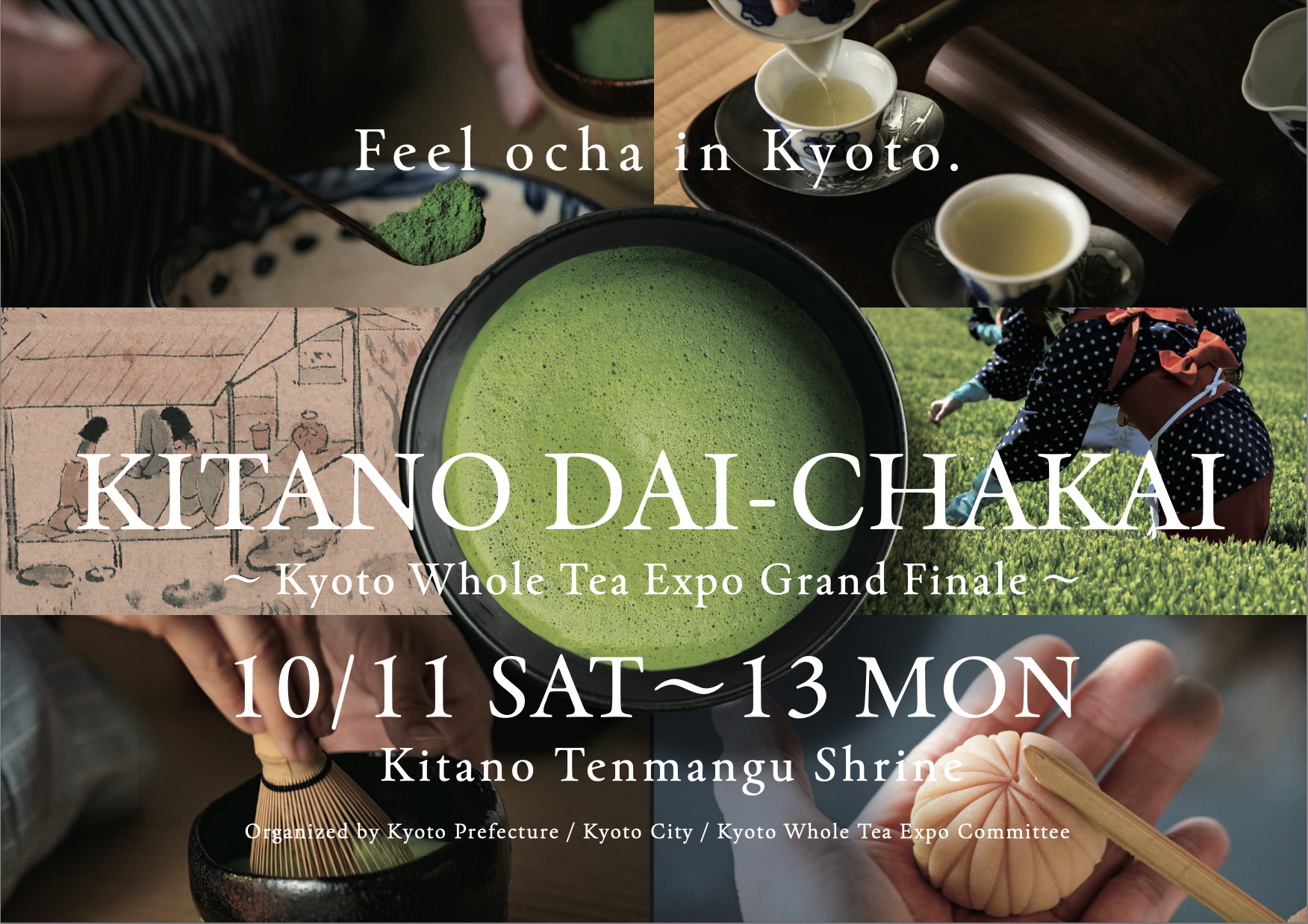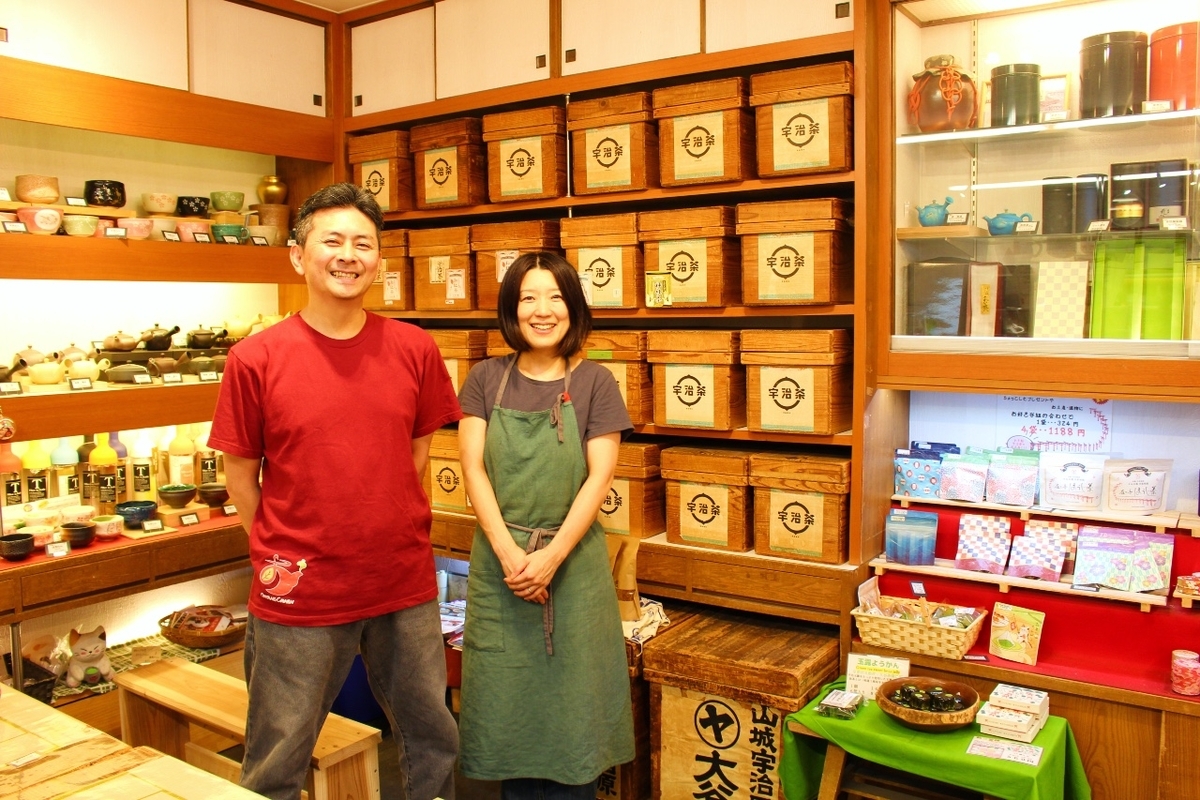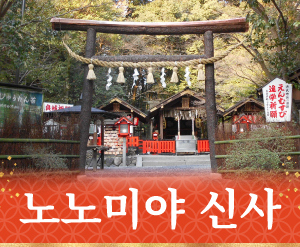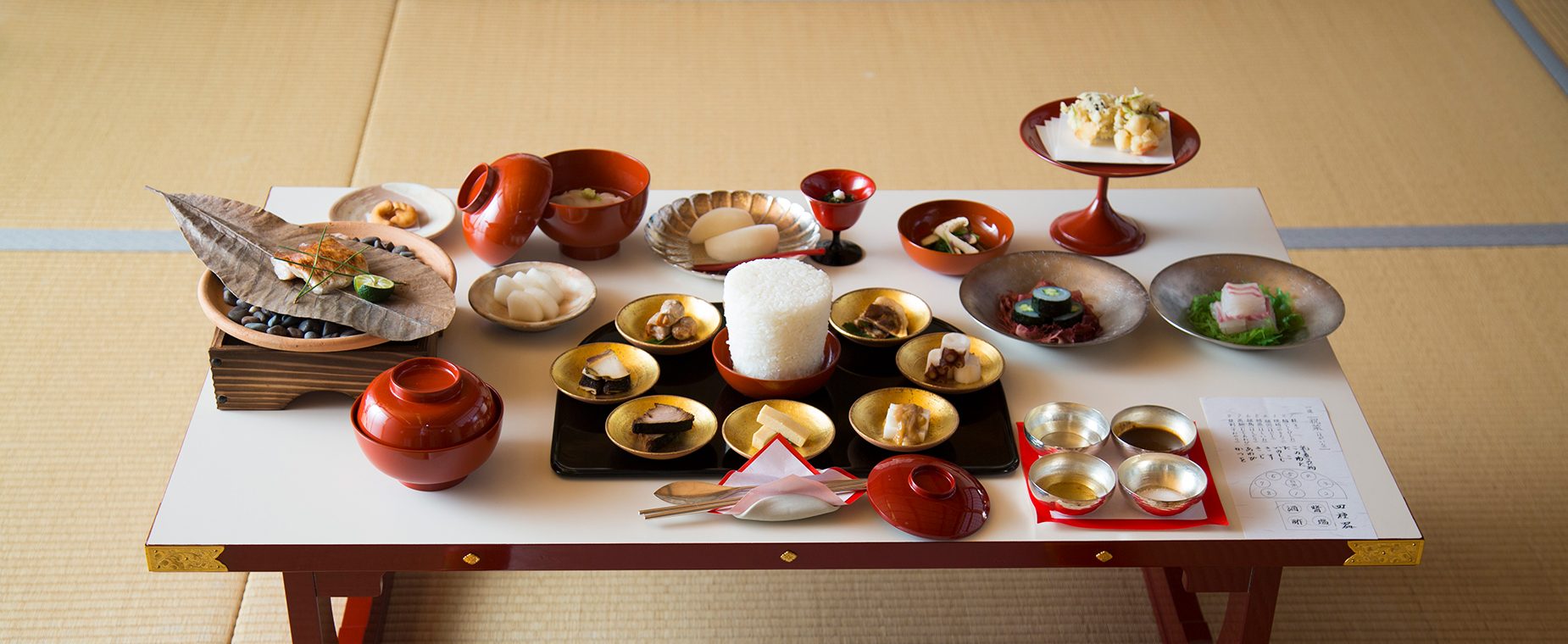
교료리 로쿠세이는 교토시 오카자키 지역에 있는 레스토랑입니다. (교료리: 교토 요리를 총칭하는 말입니다.) 1899년에 창업한 3대째 호리바 히로유키 씨는 1대째의 맛을 계승하고 있습니다. 이 레스토랑은 데오케 벤토로 유명합니다. 데오케 벤토는 교토 요리의 제철 식재료를 화려하게 담아 2대째 오케 장인인 나카가와 기요츠구가 직접 만든 나무 데오케 통에 담아 제공합니다. 하지만 잘 알려지지 않은 또 다른 명물, 헤이안 요리도 있습니다. 호리바 씨는 고전 문헌을 연구하여 이 우아한 요리를 만들어냈고, 이제 이 요리는 그의 삶의 목표가 되었습니다. 호리바 씨가 헤이안 요리를 접하고 자신만의 요리를 개발한 과정에 대한 인터뷰와 코스 요리의 정교한 사진을 함께 감상해 보세요!
호리바 히로유키 /로쿠세이 교료 3대 오너 셰프

호리바 히로유키는 1947년에 태어났습니다. 대학 졸업 후 도쿄 쓰키지의 일식당에서 수련을 받았습니다. 24세에 가업을 시작하여 선배 밑에서 실력을 갈고닦았습니다. 1994년, 교토(일본의 수도 헤이안쿄가 된 해) 천도 1200주년을 맞아 헤이안 왕조 요리를 시작했습니다. (소사쿠 헤이안 오초 요리)
로쿠세이 교료
1세대는 요식업을 시작했고, 1899년 교료리 로쿠세이를 설립했습니다. 그들은 지점을 두지 않고, 오직 주인이 직접 볼 수 있는 곳에서만 요리를 만드는 것을 원칙으로 삼았습니다. "요리는 기계가 하는 일이 아니니, 우리는 항상 상황을 예의주시하고, 주인이 만족할 만한 맛의 요리만 제공해야 한다"는 것이 그들의 원칙이며, 대대로 변함없이 지켜오고 있습니다.
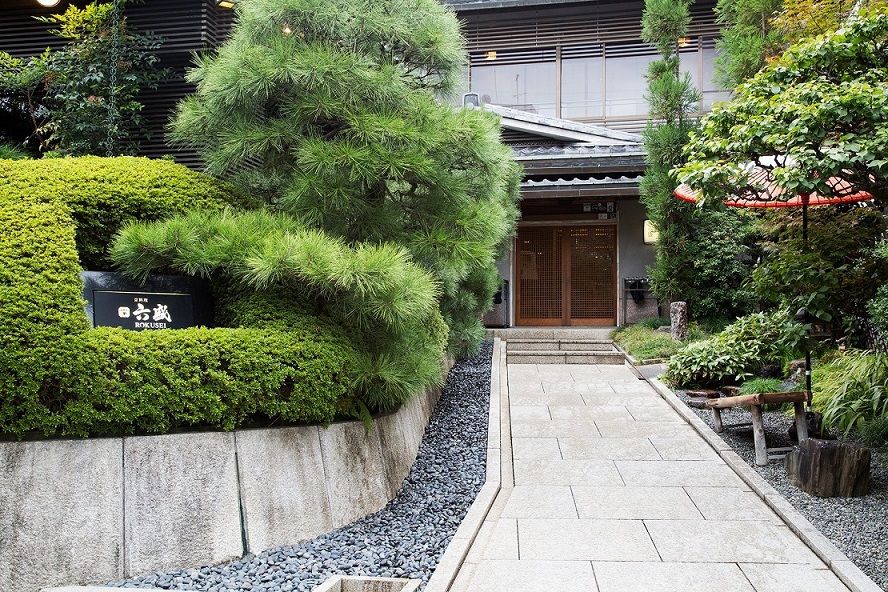
이 가게는 헤이안진구 신사 서쪽, 운하 북쪽의 쾌적한 환경에 위치해 있습니다.
회견
—– 헤이안 왕조 요리를 창조하게 된 영감은 무엇이었나요?
한번은 손님이 저에게 "교료리(교토 요리)가 정확히 무엇인가요?"라고 물었습니다. 저는 답을 찾아봤지만, 명확한 설명을 찾을 수 없었습니다. 교료리의 기원에 대한 여러 가지 설이 있는 것 같았습니다. 선불교에서 전해진 쇼진 요리(불교 채식 요리), 차노유(다도 요리)의 가이세키 요리, 혼젠 요리(무사급 요리)가 융합된 결과라는 설도 있었습니다. 저는 교료리의 기원이 헤이안 왕조 시대(794-1185)에 있을 것이라고 추측했습니다. 저는 사료와 문헌을 찾아봤지만, 옛 사진 몇 장만 찾을 수 있었고, 실제 모습을 명확하게 파악할 수 없었습니다. 저는 손님의 간단한 질문에 대한 답을 줄 수 있을 것 같아서, 저만의 답을 찾기로 했습니다.
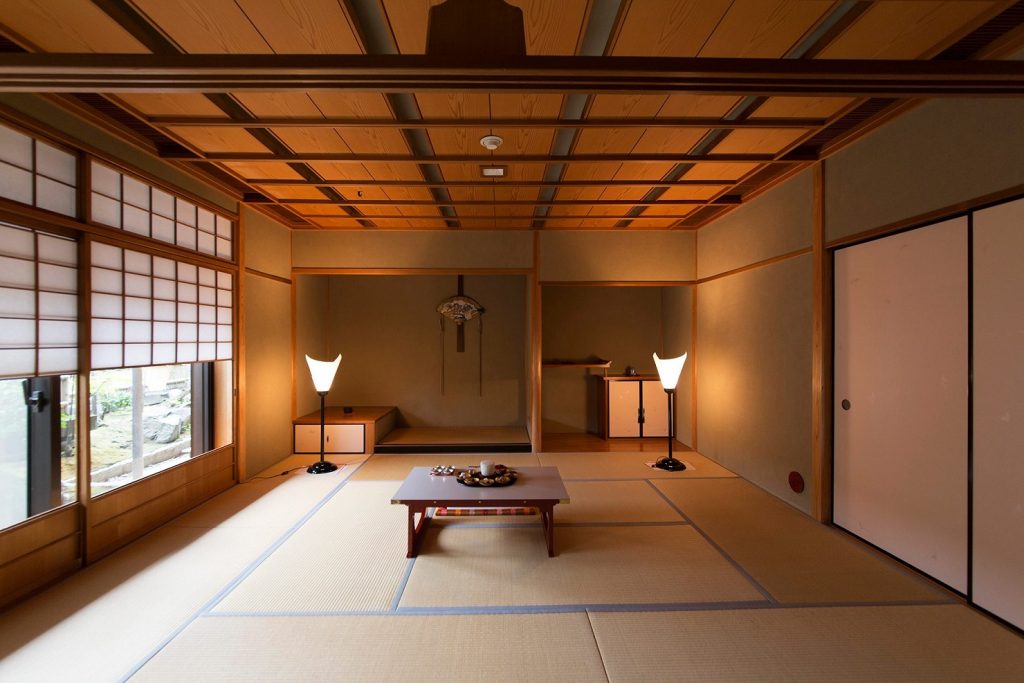
손님들은 헤이안 시대와 같은 은은한 조명이 비치는 방으로 안내됩니다.
—– 헤이안 시대의 식사는 어떤 모습이었을까?
먼저 국립국회도서관에 가서 헤이안 시대의 식문화 관련 연구 자료를 확인하고, 전문가들에게 전문 지식을 물었습니다. 그중 한 분은 식문화와 전통 요리 연구가인 오쿠무라 아야오 씨였습니다. 오쿠무라 씨는 "흥미롭네요!"라며 제 프로젝트에 많은 관심을 보였습니다. 또 다른 한 분은 복식 박물관 관장인 이즈츠 요헤이 씨입니다. 복식 박물관의 콘셉트는 "헤이안 시대의 풍속과 관습을 통해 그 세계를 느끼는 것"입니다. 이즈츠 씨는 식기와 객실 가구 배치 등 당시의 미식에 대한 풍부한 지식을 공유해 주셨습니다.
~ 안에 넨주 교지 에마키 (문자 그대로, 연중 행사를 담은 두루마리 그림. 12세기에 그려진) 귀족들의 정식 만찬이 묘사되어 있습니다. 한번은 오쿠무라 씨가 저를 위해 그 만찬을 최대한 정확하게 재현해 보려고 했습니다. 흥미로웠지만, 동시에 맛은 그다지 좋지 않다는 생각이 들었습니다. 헤이안 시대에는 요리에 양념이라는 개념이 없었습니다. 음식은 굽거나, 삶거나, 찌는 등 매우 간소하게 조리되었고, 부엌에서 양념을 하지 않았습니다. 기록에 따르면 루이쥬조우쇼 (12c) 후지와라 다다자네 대신이 히가시산조 부지에서 주최한 정식 만찬에서 다양한 해산물과 고기가 다이반이라 불리는 작은 테이블에 담겨 제공되었고, 각 사람은 다이반이라 불리는 4가지 양념 세트를 사용했습니다. 요구사모노 요리 앞에 놓아서 원하는 대로 양념할 수 있도록 했습니다.

첫 번째 코스 – 호가이나
건강과 장수를 기원하는 애피타이저. 다이반 처음부터 트레이. 중앙에 있는 키가 큰 원통형 마운드는 2세 (쌀)이라고 불리는 오모노. 밥은 풍성하게 나오는데, 관습에 따르면 다 먹지 않아도 괜찮습니다. 밥을 둘러싼 요리는 다음과 같습니다. 오마와리 (문자 그대로, 주변), 또는 깨어 있다 (문자 그대로, 동반하다) 밥과 함께 곁들여 먹으니까. 요리의 개수가 많을수록 더 맛있다고 여겨졌기 때문에 이런 단어가 붙었다. 오카즈, 현대 일본어에서 밥과 함께 제공되는 요리를 의미하며 문자 그대로는 "숫자"를 의미합니다. 손님은 양념을 합니다. 오마와리 네 가지 종류의 양념을 사용하여 원하는 대로 요리할 수 있습니다. 오마와리 가운데 흰쌀밥과 함께 먹습니다. 하지만 호리바 씨의 편에서는 각 요리에 풍미가 더해져 사케와도 잘 어울립니다. 오마와리 (아래 중앙에서 시계 방향으로): 그래서 우유를 끓여서 만든 고대 치즈의 한 종류 시시비시오 일종의 시오카라 (소금에 절여 발효시킨 해삼의 내장, 사진은 해삼입니다), 야키타코 구운 문어, 호지시 원본 나마스 양념한 고기(사진: 멧돼지고기) 호시이오 말린 생선(사진: 소금을 뿌려 구운 대구) 호시도리 소금에 절여 햇볕에 말린 가금류(사진: 구운 꿩) 무시아와비 찐 전복, 수와야리 말린 생선 조각. (사진: 훈제 가다랑어)
—– 네 가지 조미료는 무엇이었나요?
식초, 사케, 소금 그리고 히시오. 히시오 간장의 원조로 알려진 소스였습니다. 재료는 히시오해산물이나 가금류와 같은 식품은 보존을 위해 소금에 절인 후 말렸을 가능성이 높습니다.
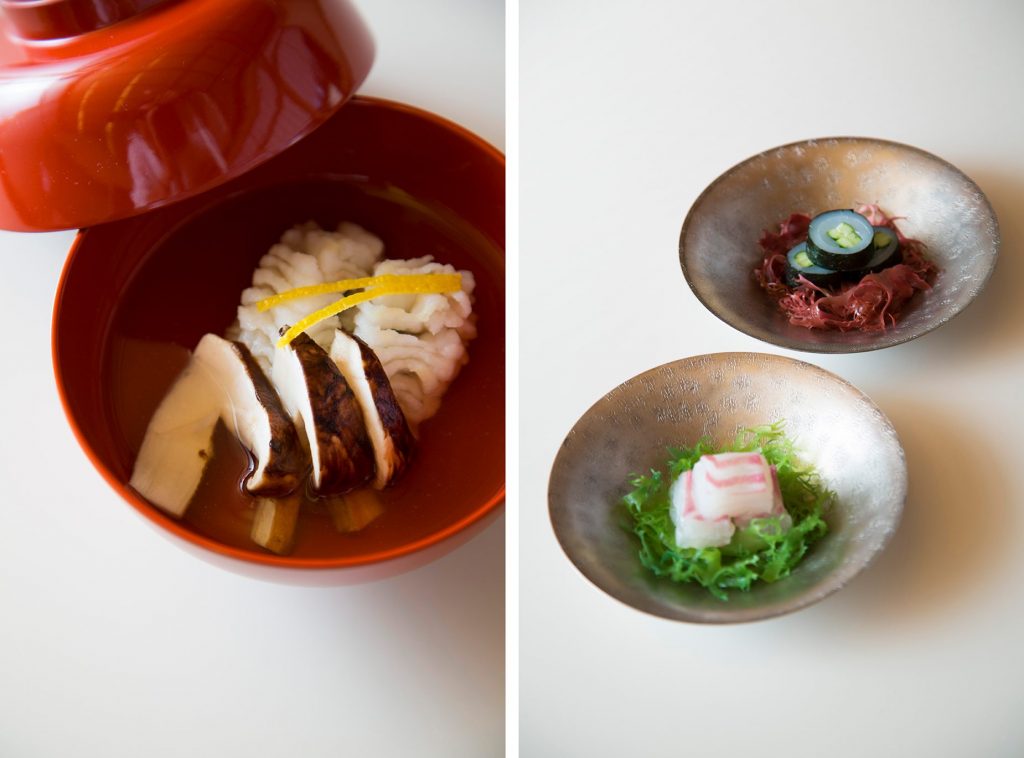
두 번째 코스 - 아츠모노(왼쪽)
그 당시에는 요리가 미리 조리되어 식탁에 차려져 있었기 때문에 모두 차가웠습니다. 따뜻하게 제공되는 음식은 수프뿐이어서 수프라는 이름이 붙었습니다. 아츠모노 (문자 그대로, 따뜻한 요리). 사진: 가을철에 먹는 콩거 장어와 송이버섯을 넣은 국. 계절을 나타내는 풍부한 향이 특징입니다.
세 번째 코스 - 카센(오른쪽)
사시미(생선회). 바다에서 멀리 떨어진 수도 교토에서 날생선을 먹을 수 있다는 것은 최고의 사치로 여겨졌습니다. 사진: 사시미 옛날처럼 깡통 접시에 도미와 오징어를 층층이 쌓아 올려 놓은 요리입니다.
—– 고대 자료에는 무엇이 묘사되어 있나요?
밥, 국그릇, 작은 잔에 담긴 반찬, 조개류, 날것의 해산물이나 고기, 말린 해산물이나 고기, 그리고 야채 요리가 다이반(大坊)에 담겨 나왔습니다. 사진을 보면 화려해 보이는데, 아마도 사람들이 실제로 맛보기보다는 시각적인 아름다움을 더 중시했기 때문일 것입니다.
이즈츠 씨에 따르면, 헤이안 시대의 귀족들에게는 식사라는 행위가 매우 사적인 것으로 여겨졌기 때문에 미식가의 관점에서 음식에 대해 이야기하는 것은 저속한 것으로 여겨졌습니다. 심지어 다른 사람들 앞에서 식사하는 것조차 기피했습니다. 아마도 그래서 식사와 관련된 많은 기록이나 표현을 남기지 않았을 것입니다.
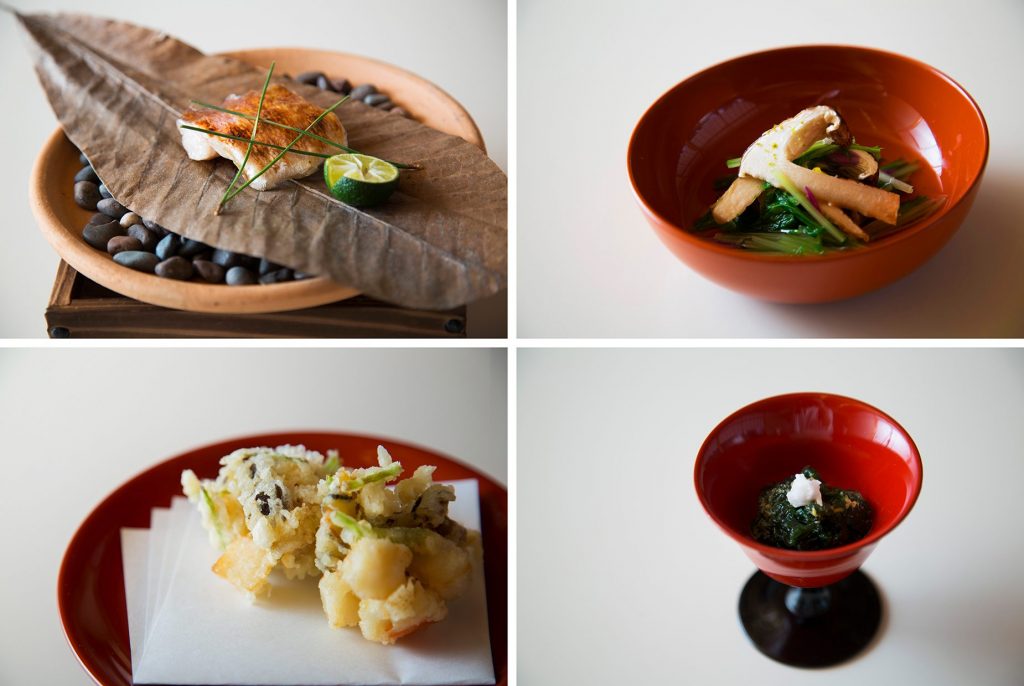
네 번째 코스 - 아부리모(좌상단)
오늘날과 동일 야키모노 (구운 요리). 이 요리는 헤이안 시대에 주로 굽는 방식으로 조리되었습니다. 된장이나 간장으로 맛을 내는 과정을 동반한 굽기는 헤이안 시대 이후에 시작되었다고 합니다. 무로마치 시대(1336-1573). 사진: 소금을 뿌려 구운 옥돔. 옥돔을 섬세한 비늘과 함께 바삭하게 구운 다음, 유약을 바르지 않은 토기에 뜨거운 돌멩이를 얹어 제공합니다.
다섯 번째 코스 - 초사이(오른쪽 위)
야채와 건조식품을 주로 사용한 요리. 니모노 (국물에 끓여서 먹는 요리의 종류)와 아에모노 (소스를 곁들인 요리)는 무로마치 시대 이후에 만들어졌는데, 호리바 씨의 편찬에 추가되었습니다. 사진: 마츠타케 버섯과 미즈나 (겨자잎의 일종) 국물에 오히타시.
여섯 번째 코스 - 아게모노(왼쪽 아래)
사실 헤이안 시대에는 튀긴 음식은 튀김과자뿐이었다. 카라가시; 다시 말하지만, 다른 튀김 요리가 등장한 것은 무로마치 시대 이후입니다. 이 또한 호리바 씨의 특별한 조리법의 일부입니다. 사진: 튀김 사자에 (터보), 시메지 버섯, 그리고 미츠바 파슬리.
일곱 번째 코스 - 구보츠키모노(오른쪽 아래)
오늘의 스노모노 (식초를 넣은 요리) 잔에 담아 제공합니다. 원래 건조 식품은 단순히 물에 불려 재가열했고, 날것의 식품은 그냥 잘게 썰어 식초에 헹궜습니다. 사진: 스이젠지놀이, 담수조류의 일종.
—– 궁정 요리에 대한 연구가 어떻게 헤이안 왕조 요리를 창조하는 데 도움이 되었나요?
1994년 교토(일본의 수도로 지정된 헤이안쿄) 천도 1200주년을 기념하여 새로운 요리를 선보이고 싶어서, 헤이안 궁중 요리를 고객 여러분께 선보이기로 했습니다. 왕조의 요리에 대한 연구를 시작한 지 5년이 지났고, 수많은 시행착오를 겪은 끝에 마침내 저희 레스토랑에서 선보일 만큼 만족스러운 요리를 개발할 수 있었습니다.
시대의 흐름에 맞춰 간단한 양념과 여러 가지 건어물만으로 만족스러운 요리를 만들어내는 것은 쉽지 않았습니다. 교토까지 찾아와 식사를 즐기는 손님들에게 교토다운 화려함, 즉 다양하고 풍미 가득한 요리가 눈으로 보기에도 아름답게 펼쳐지기를 바라는 것은 당연한 일입니다.
그래서 저는 천 년 전의 맛을 단순히 재현하는 데 그치지 않고, 헤이안 궁중 연회에서 얻은 영감을 바탕으로 독창적인 아이디어를 더하기로 했습니다. 진한 다시 국물을 사용하고, 다양한 풍미를 창의적으로 더하여 현대인의 입맛에 맞춘 요리를 만들었습니다. 바로 이것이 헤이안 왕조 요리입니다.
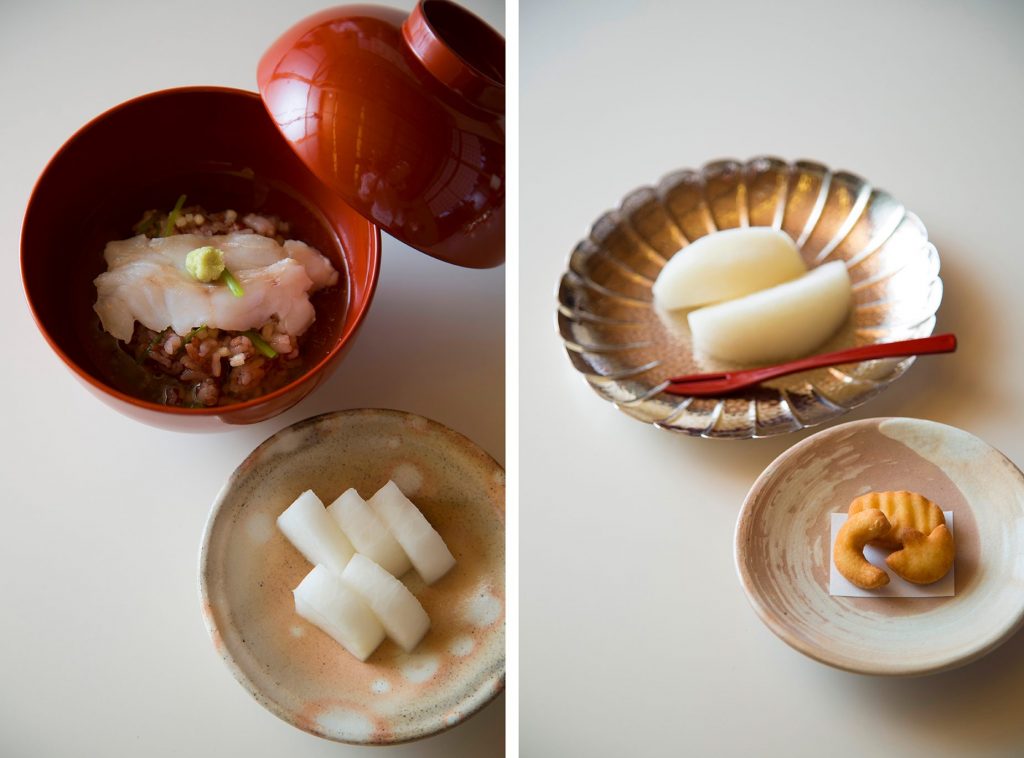
여덟 번째 코스 - 히메이(왼쪽)
길조의 붉은색 아카고메 (붉은 밥)이 더 좋아요. 사진: 붉은 밥 위에 찐 타일피시, 무 쌀겨에 절인 무.
9번째 코스 - 키가시(오른쪽 위)
헤이안 시대에는 '과자'가 과일을 의미했습니다. 밤, 귤, 살구, 복숭아, 감 등이 제공되었습니다. 사진: 나시 (아시아 배)
10번째 코스 - 카라가시(오른쪽 아래)
튀긴 과자라고도 불리는 카라쿠다모노쌀가루, 밀가루, 콩, 팥 등을 반죽하여 튀겨 만든 음식 아마즈라 (설탕 대신 사용되는 야생 포도나무 수액)이나 물엿. 당시에는 특히 이국적인 모양이 선호되었습니다. 사진: 밀가루와 꿀을 반죽하여 튀긴 모습.
—– 구체적으로, 그 시대의 어떤 특징이 재현되도록 선택되었나요?
첫째, 음식의 외관입니다. 당시 대연회 음식의 원칙은 음식이 타카모리, 높은 언덕에. 이것이 일본 음식이 제공되는 기본적인 방식의 기원일 가능성이 높습니다. 다테모리음식을 세로로 강조하여 배치하는 스타일입니다. 둘째, 식기입니다. 젓가락은 카이 그 당시에는 젓가락과 숟가락이 은으로 만들어졌고, 식기는 우루시 칠기, 무유약 토기, 은식기, 그리고 황동. 셋째, 서빙 스타일. "잇키 잇슈 (한 그릇에 한 종류)”는 한 접시에 여러 가지 음식을 담아 제공하는 대신, 각 음식이 별도의 접시나 그릇에 담겨 제공되었습니다. 넷째, 다이반 탁자. 궁정 시녀들이 보관하는 방이 있었습니다. 다이반 특별한 주의가 필요한 테이블이라고 불리는 다이반도코로아마도 일본어로 '부엌'을 뜻하는 단어 '다이도코로'의 어원일 것입니다. 다섯째, 좌석입니다. 자부톤 (솜을 채워 넣은 쿠션 좌석) 휴대용 다다미 매트를 사용하곤 했습니다. 시톤 바닥에 놓고 식사할 수 있는 자리로 만들었습니다. 저희 식당에서도 헤이안 시대 분위기를 최대한 재현하고 싶어서 은으로 만든 젓가락과 숟가락을 준비했습니다. 다이반 테이블과 시토네 매트는 이러한 목적에 맞게 맞춤 제작되었습니다.
또한, 헤이안 왕조 요리를 선택하신 손님을 객실로 안내할 때는 객실 내 모든 조명을 끄고, 안돈 (전통적인 스타일의 플로어 램프). 방의 가구들, 귀족들의 상징이었던 고전적인 직물 스크린들 – 안녕-오기 (사이프러스 부채) – 장식되어 있습니다 도코노마 벽감과 희미하게 밝혀진 방을 가득 채우는 향의 은은한 향기는 모두 세상을 완벽하게 표현합니다. 그림자의 찬양 (소설가 J 다니자키의 일본 미학에 대한 에세이). 손님들은 먼저 쿠스자케(향신료를 넣은 사케) 한 잔을 받고 건배합니다. 그런 다음 불이 켜지고 미식의 즐거움이 시작됩니다. 궁중의 경험이 시작되는 순간입니다.
---- 마지막으로, 앞으로 해보고 싶은 일이 있나요?
음, 궁중 요리 연구는 제게 평생의 업과도 같습니다. 오늘 보여드린 것은 하나의 성취입니다. 하지만 연구가 어떻게 진행될지에 따라 새로운 발전의 가능성을 부정하지는 않겠습니다. 교토의 셰프로서 저는 교료리의 원류라고 믿는 궁중 요리에 대한 저만의 해석을 구체화해 왔고, 많은 분들이 찾아와 맛보셨으면 좋겠습니다. 손님들이 각각의 요리에서 영감을 얻고 헤이안 시대의 분위기를 만끽하시기를 바랍니다. 궁극적으로 헤이안 시대 요리가 로쿠세이의 새로운 대표 요리가 된다면 정말 기쁠 것입니다.
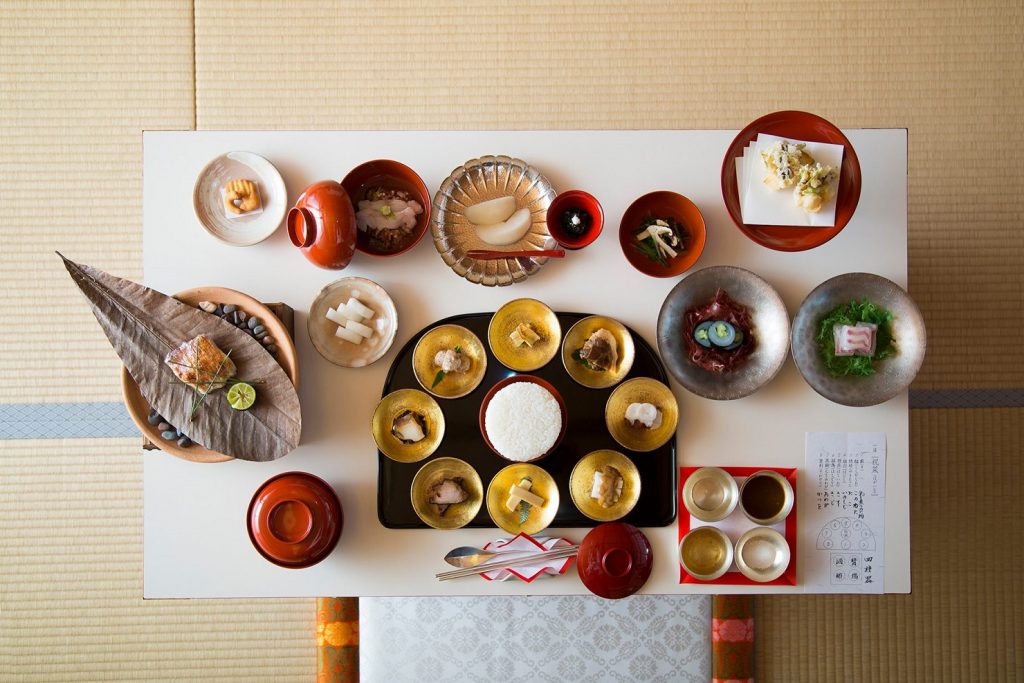
헤이안 왕조 요리 (소사쿠 헤이안 오초 요리)
13,200엔 (세금 포함/ 15% 서비스 수수료 별도), 인원: 2~12명, 1주일 전 예약 필수
로쿠세이 교료
주소: 교토시 사쿄구 오카자키 니시텐노초 71
영업시간: 평일 11:30 – 14:00 / 16:00 – 21:00 (LO 20:00); 토, 일 및 공휴일 11:30 – 21:00 (LO 20:00)
휴무일: 월요일 (공휴일은 영업)
전화: 075-751-6171
공식 웹사이트
회견
MAE KOORI의 글
사진: 타나카 유스케
2020년 11월 17일 월요일 15:37


